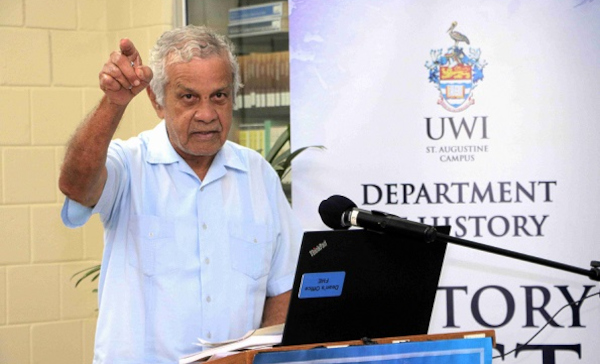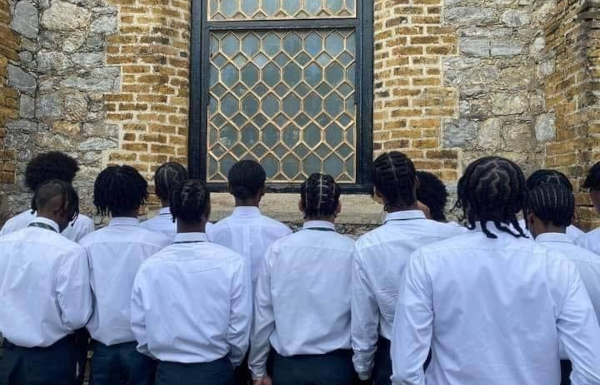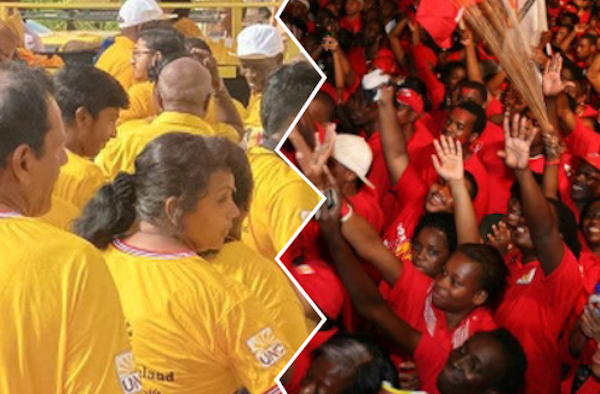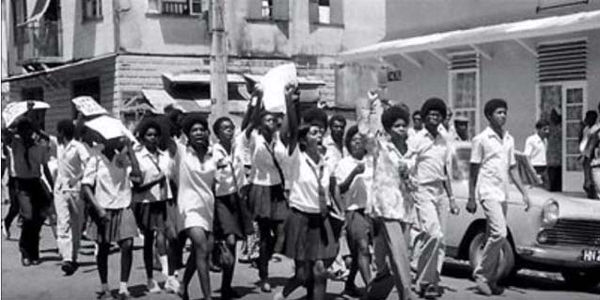“[…] The new consciousness defined new ways of looking at ourselves, at our fellow brothers and sisters and humanity as a whole. It enlightened our philosophies and vision, as well as our hopes and aspirations. It advised our system of values, clarified our sense of justice and dictated the growth of a new purpose in our lives.
“The growing regional consciousness also awakened a new meaning for life among Caribbean people, in keeping with the values, principles and objectives of the Revolution. The new values were primarily driven by respect. Respect for our people’s history, creativity and achievement over time…”
The following is the eighth column in an NJAC series on their contribution to Trinidad and Tobago society after the ‘Black Power Revolution’ of 1970:

(Copyright AP Photo)
The Trinidad and Tobago Revolution of 1970, also known as the Black Power Revolution, created a ‘new consciousness’ in T&T and the Caribbean. This new consciousness brought a positive shift in the mindset of the population. It introduced a way of thinking which reflected a deep concern for progress, nation-building and human elevation.
The new consciousness of the 1970s was grounded in people and placed people at the centre of all national and community processes. It was firmly grounded in a deep sense of responsibility and a commitment to securing equality and justice for everyone in Trinidad and Tobago.
Creating a positive mental shift within the population was necessary to prepare for any successful nation-building effort. NJAC, therefore, rolled out a mass education agenda using every device available to enlighten the population. Public meetings were used, in the words of Chief Servant Makandal Daaga, to ‘educate, elevate and agitate’ the population.
Demonstrations were transformed into ‘schools’, with speakers discussing all subjects, areas of development and pursuits of life while they marched. Microphones would be placed at strategic points in the demonstration so that as many as five or six speakers could address different sections of the massive marches at the same time.

(Courtesy Embau Moheni/NJAC)
Every opportunity was used on the long journeys of the daily demonstrations to provide information, analysis and guidance for the masses to maximise their all-round development.
NJAC also printed the Liberation, a national newspaper, and a host of pamphlets and booklets as part of its campaign for national enlightenment. During that period, NJAC formed groupings or zones in communities all over T&T.
One of the first duties of a new zone was to produce its own area paper or pamphlet. This exercise led to more research being done on the conditions in various communities across the country, the emergence of a host of very good writers and a greater flow of information to and from all parts of our nation.
An ‘each one, teach one’ approach also emerged out of the Revolution. It involved learning and teaching simultaneously, thus fortifying the learning process and building members’ confidence. There was a role for everyone. If you had just begun to learn and you were at level one, you had a duty to teach someone at level zero.
Academic qualifications did not matter. The person at level zero could be a university lecturer but one who knew nothing about the principles of the Revolution. What was important and necessary was a desire to learn, a willingness to teach and the humility for the process to work smoothly.

(courtesy NJAC)
Thousands of books, in virtually all subject areas, were imported to further enlighten the people. The results of this campaign were so profound, that it was often said that if you spent six months in NJAC, you would have acquired the equivalent competence of a university graduate.
The information flow, however, was by no means a one-way road. The masses gathered information very diligently in their various communities across the nation, in places of work, places of entertainment and relaxation, on the streets and in their institutions of learning. Important and relevant information was brought to the NJAC leadership, which was disseminated back to the national population.
This two-way information flow between the masses and the leadership was called the ‘grapevine’. The grapevine was a fantastic communication network, created and implemented by the grassroots, which reflected the creativity and vast operational potential of the masses when so motivated.
The speed (almost instantaneous responses) and effectiveness made the grapevine a potent tool in the process of enhancing and driving the new consciousness. In the run-up to 1981 general elections, NJAC introduced a pamphlet carrying the name ‘Birdvine’, which sought to replicate certain aspects of the grapevine system.
All these powerful initiatives of the T&T Revolution surfaced in a massive outpouring of information, ideas and philosophies, giving birth to the new consciousness which swept Trinidad and Tobago and overflowed up the Caribbean in what Brother Valentino calls the ‘Roaring Seventies’.

(Copyright Apoesho Mutope/NJAC)
There was the ‘black consciousness’, which inspired widespread efforts to restore dignity and self-worth to the black communities (including, but not exclusive to, African, Indian and Indigenous Peoples). In this regard, special emphasis had to be placed on the Africans, who had suffered the most brutal and dehumanising assaults of all peoples.
The decimation of their identity, religions, community and family life, self-image and way of life generally, has no parallel in human history.
Then there was the ‘national consciousness’, which reflected a strong sense of responsibility for the building of a nation whose ‘ideological basis is man…’. Finally, a ‘Caribbean consciousness’, in recognition of the common historical experiences we share with our Caribbean brothers and sisters, and which suggests the wisdom of pursuing a common destiny.
NJAC also recognised that a unified approach to the task of nation-building was a clear necessity. The movement, therefore, initiated a thrust to create bonds of unity and love throughout our nation. The entire nation was redefined as a family, employing one of our founding principles, ‘Be a brother, be a sister.’
We, thus, saw ourselves as belonging to one family, one for all and all for one. This inspired a new love across our land, uniting communities, mending broken relationships, removing enmities and encouraging people to rise above petty differences.

(Courtesy Embau Moheni/NJAC)
So powerful was the new brotherhood and sisterhood that the crime rate declined by a record 56% in 1970.
Never before, nor since, has our nation enjoyed such an immense success against the crime scourge. NJAC and the masses exhibited, beyond the shadow of a doubt, the people’s inborn ability to work in unity and harmony once they were respected and had a meaningful say in determining their own affairs (People’s Participation).
The government and power elite felt threatened by the growing unity the masses were building in 1970. The continued domination by the ‘power elite’ was and continues to be based on the policy of divide and rule. The new unity was viciously attacked during the seven-month state of emergency (April 21st to November 20th).
Of all NJAC’s principles, the two which received the severest and most persistent attacks were ‘Unite the nation’ and ‘Be a brother, be a sister.’ Fifty years after 1970, we must learn from the lessons of that most instructive historical moment of national inspiration.
We must recognise that until we restore strong bonds of community, love and unity to our nation it will be impossible for us to build a nation which will ensure peace and prosperity for our families and communities.
The new consciousness defined new ways of looking at ourselves, at our fellow brothers and sisters and humanity as a whole. It enlightened our philosophies and vision, as well as our hopes and aspirations. It advised our system of values, clarified our sense of justice and dictated the growth of a new purpose in our lives.

(Copyright AP Photo)
The growing regional consciousness also awakened a new meaning for life among Caribbean people, in keeping with the values, principles and objectives of the Revolution. The new values were primarily driven by respect. Respect for our people’s history, creativity and achievement over time.
Today, in 2020, after 50 years of denial, both of the significance of the 1970 Revolution as well as the critical role of the masses in national affairs, this new consciousness has been practically erased from the awareness of the present generation.
We must, first, express our thanks and deepest gratitude to the chief servant and NJAC, and equally, to the population, for the sacrifices they embraced to give birth to the new consciousness. The black consciousness, national consciousness and Caribbean consciousness remain a lasting tribute to NJAC’s vision and people’s power.
The dawn of the new consciousness reflected NJAC’s drive to empower the masses. While the mass education programme may have been most instrumental in the creation of the consciousness, equally important would have been the great respect the Revolution offered to the masses.
People were respected based on their humanity and not because they had property, or money or high office. They were respected based on their willingness to live by the principles of the Revolution. These are principles which promote brotherhood and sisterhood and a strong commitment to working for a new and just society.

The T&T population must be given the highest regard for the role that they played in fanning the flames of the new consciousness. The brothers on the blocks, in particular, deserve the highest commendation for transforming the ‘blocks’ from areas of negativity into centres of learning, progressive ideas and meaningful activities.
Those brothers would march by day and then research books on life, philosophy, economics, etc, under the streetlights at night. Their diligence and example did much to anchor the new consciousness as a vehicle for national transformation and human development.
“There is no greater thing than opening up a man’s eye, more than putting money in his pocket.” Chief Servant Makandal Daaga—ORTT
Want to share your thoughts with Wired868? Email us at editor@wired868.com.
Please keep your letter between 300 to 600 words and be sure to read it over first for typos and punctuation.
We don’t publish anonymously unless there is a good reason, such as an obvious threat of harassment or job loss.
 Wired868 Wired868 for smart sport news and opinion
Wired868 Wired868 for smart sport news and opinion







Indians in trinidad and around the globe identified in 1970 up until recent times as ‘caucasian’ and white. Kamala Harris’s mother’s documents have made the rounds, and she also listed herself as WHITE her entire life. The central, core, foundational principle of brahmanists, is WHITE SUPREMACY!Hence, indians found “BLACK power” as a concept morally, spiritually, intellectually and politically offensive…which is precisely why a sparse handful participated earnestly in 1970’s Black Power uprising.